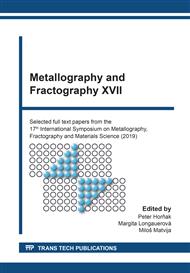[1]
J. Brezinová, et al., Effect of working temperatures on properties of continuous steel casting rolls cladding layers, Chem. Listy 106, S3 (2012) 387-389.
Google Scholar
[2]
J. Viňáš, et al., Evaluation of the quality of cladding deposited on continuous steel casting rolls, Int. J. Mater. Res. 104, 2 (2013) 183-191.
DOI: 10.3139/146.110842
Google Scholar
[3]
J. Brezinová, J, Viňáš, P. Maruschak, A. Guzanová, D. Draganovská, M. Vrabeľ, Sustainable Renovation within Metallurgical Production, 1st ed.; RAM–Verlag: Lüdenscheid, Germany, (2017).
Google Scholar
[4]
J. Viňáš, J. Brezinová, A, Guzanová, Analysis of the quality renovated continuous steel casting roller, Sadhana-Acad. Proc. Eng. Sci. 38 (2013) 477-490.
DOI: 10.1007/s12046-013-0119-3
Google Scholar
[5]
P. Mohyla, K. Foldynová, Influence of Post Weld Heat Treatment on Mechanical Properties of P92 Welds Made by Submerged Arc Welding, Met. Sci. Heat. Treat. 56 (2014) 206-209.
DOI: 10.1007/s11041-014-9732-y
Google Scholar
[6]
J. Janovec, A. Výrostkova, A. Holý, Effect of tempering on development of carbide particles in 2.7Cr0.6Mo0.3V steel, J. Mater. Sci. 27 (1992) 6564–6572.
DOI: 10.1007/bf01165937
Google Scholar
[7]
J. Viňáš, Study of influence adhesive wearing surfaces on renovation surfaces, Acta Mech. Slovaca 7, 4-A (2003) 173-176.
Google Scholar
[8]
C. Gagg, P. Lewis, Wear as a product failure mechanism-Overview and case studies, Eng. Fail. Anal. 14 (2017) 1618-1640.
DOI: 10.1016/j.engfailanal.2006.11.064
Google Scholar
[9]
J. Brezinová, et al., Influence of the hardfacing welds structure on their wear resistance, Metals 6, 2 (2016) 1-12.
Google Scholar
[10]
M.F. Frolisch, Design Criteria for Rolling Contact Fatigue Resistance in Back‐up Rolls, Ph.D. Thesis, University of Sheffield, Mappin Street, Sheffield, UK, (2002).
Google Scholar
[11]
J. Brezinová, A. Guzanová, Possibilities of utilization high velocity oxygen fuel (HVOF) coatings in conditions of thermal cyclic loading, Metalurgija 51, 2 (2012) 211-215.
Google Scholar
[12]
J. Viňáš, J. Brezinová, A. Guzanová, J. Svetlík, Degradation of renovation layers deposited on continuous steel casting rollers by submerged arc welding, Proc. Inst. Mech. Eng. B J. Eng. 227 (2013) 1841-1848.
DOI: 10.1177/0954405413493405
Google Scholar
[13]
J. Viňáš, M. Greš, T. Vaško, Cladding of wear-resistant layers in metallurgy and engineering, Mat. Sci. Forum, 862, Novel Trends in Production Devices and Systems 3. Switzerland (2016) 41- 48.
DOI: 10.4028/www.scientific.net/msf.862.41
Google Scholar
[14]
F.M. Patricio, et al., Welding processes for wear resistant overlays, J. Manuf. Process. 16, 1 (2014) 4-25.
Google Scholar
[15]
J. Viňáš, Selection respectable filling materials for renovation functional surfaces to big tension straining, Acta Mech. Slovaca 8, 2 (2004) 465- 470.
Google Scholar
[16]
M. Raffi, et al., Microstructure, Mechanical and Corrosion Behaviour of Weld Overlay Cladding of DMR 249A steel with AISI 308L, Materials Today: Proceedings, Vol. 15, Part 1, (2019) 2-10.
DOI: 10.1016/j.matpr.2019.05.017
Google Scholar
[17]
V. Paulson, et al., Weld overlay coating of Inconel 617 M on type 316 L stainless steel by cold metal transfer process, Surf. and Coat. Tech. 357 (2019) 1004-1013.
DOI: 10.1016/j.surfcoat.2018.10.073
Google Scholar
[18]
S.S. Sandeep, et al., Metallurgical, wear and fatigue performance of Inconel 625 weld claddings, J. Mater. Process. Tech. 233 (2016) 1-8.
Google Scholar


